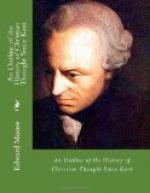historical point can be found at which the growth of
doctrine ceased and the rule of faith was once for
all settled, therefore an infallible authority outside
of the development must have existed from the beginning,
to provide a means of distinguishing true development
from false. This infallible guide is, of course,
the Church. It seems incredible that Newman could
escape applying to the Church the same argument which
he had so skilfully applied to Scripture and dogmatic
history. Similar is the case with the argument
of the Grammar of Assent. ’No man
is certain of a truth who can endure the thought of
its contrary.’ If the reason why I cannot
endure the thought of the contradictory of a belief
which I have made my own, is that so to think brings
me pain and darkness, this does not prove my truth.
If my belief ever had its origin in reason, it must
be ever refutable by reason. It is not corroborated
by the fact that I do not wish to see anything that
would refute it.[8] This last fact may be in the highest
degree an act of arbitrariness. To make the impossibility
of thinking the opposite, the test of truth, and then
to shut one’s eyes to those evidences which
might compel one to think the opposite, is the essence
of irrationality. One attains by this method
indefinite assertiveness, but not certainty.
Newman lived in some seclusion in the Oratory of St.
Philip Neri in Birmingham for many years. A few
distinguished men, and a number of his followers,
in all not more than a hundred and fifty, went over
to the Roman Church after him. The defection
was never so great as, in the first shock, it was
supposed that it would be. The outward influence
of Newman upon the Anglican Church then ceased.
But the ideas which he put forth have certainly been
of great influence in that Church to this day.
Most men know the portrait of the great cardinal, the
wide forehead, ploughed deep with horizontal furrows,
the pale cheek, down which ’long lines of shadow
slope, which years and anxious thought and suffering
give.’ One looks into the wonderful face
of those last days—Newman lived to his
ninetieth year—and wonders if he found in
the infallible Church the peace which he so earnestly
sought.
[Footnote 8: Fairbairn, Catholicism, Roman and Anglican, p. 157.]
MODERNISM
It was said that the Oxford Movement furnished the rationale of the reaction. Many causes, of course, combine to make the situation of the Roman Church and the status of religion in the Latin countries of the Continent the lamentable one that it is. That position is worst in those countries where the Roman Church has most nearly had free play. The alienation both of the intellectual and civil life from organised religion is grave. That the Roman Church occupies in England to-day a position more favourable than in almost any nation on the Continent, and better than it occupied in England at the beginning




